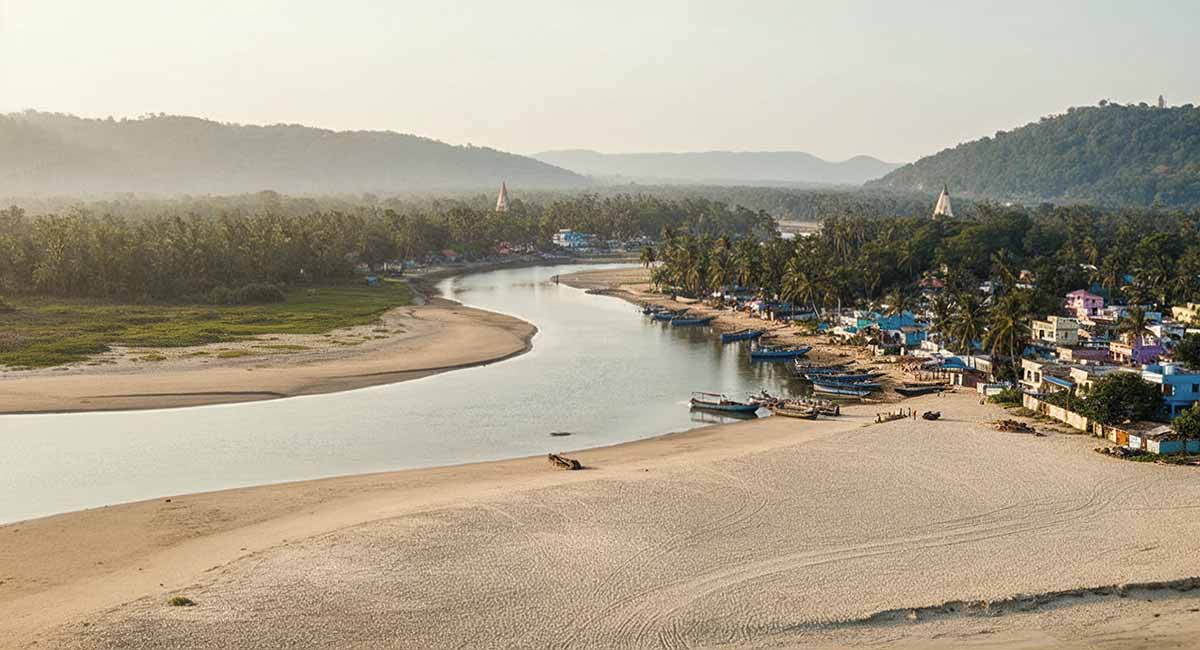Rushikulya River: The Lifeline of Southern Odisha
Situated in the heart of southern Odisha, the Rushikulya River is one of the state’s most significant and scenic rivers. Often overshadowed by the more famous Mahanadi and Brahmani rivers, Rushikulya holds immense ecological, cultural, and economic importance. The river, which rises in the Eastern Ghats and flows east into the Bay of Bengal, feeds rare animals and nourishes the area it passes through. It is primarily a global hotspot for Olive Ridley sea turtle mass nesting.
Origins and Path of the River
The Rushikulya River originates from the Rushimala Hills near Daringbadi in the Kandhamal district of Odisha. This steep and forested area, around 1,000 meters above sea level, gives the river a plentiful water supply. The river flows about 165 kilometers, passing through the districts of Kandhamal, Ganjam, and a part of Boudh, before emptying into the Bay of Bengal near Puruna Bandha in Ganjam district.
The Rushikulya basin spans over 7,700 square kilometers, covering a significant area of Odisha. Major towns along its banks include Bhanjanagar, Aska, and Chhatrapur, with Berhampur, the state’s commercial hub, situated nearby. Several tributaries, including the Baghua, Badanadi, and Loisingha, also join the river, which enhances its volume and reach.
Ecological Significance of the River
The Rushikulya River plays a pivotal role in the ecology of southern Odisha. The river and its basin support a wide range of flora and fauna, sustaining dense forests, fertile farmlands, and numerous wetlands. The Rushikulya River’s estuary, which serves as a vital breeding and nesting area for the endangered Olive Ridley sea turtles (Lepidochelys olivacea), is its most notable ecological feature.
Every year, between February and March, thousands of Olive Ridley turtles come ashore along the beaches near the river’s mouth, especially at Rushikulya rookery near Gokhurkuda and Podampeta villages, for mass nesting – a phenomenon known as “arribada.” This is one of the largest turtle nesting sites in the world, alongside Gahirmatha and Devi River beaches in Odisha. This unique wildlife spectacle has brought global attention to the otherwise quiet region.
Conservation efforts, driven by both government and local communities, have helped protect this delicate ecosystem. Organizations monitor turtle nesting, safeguard hatchlings, and work to prevent poaching and pollution along the nesting beaches.
Agricultural and Economic Importance
For the people of Ganjam and surrounding districts, the Rushikulya River is nothing less than a lifeline. It supports extensive agricultural activities, providing essential irrigation for crops such as paddy, sugarcane, pulses, and vegetables. The river’s water is channeled through numerous canals and lift irrigation schemes to farmlands miles from the riverbank.
The Aska Cooperative Sugar Industries Limited (ACSIL), located in Aska, heavily depends on the Rushikulya for water. The river supports other agro-based industries and small-scale fishing communities and supplies water to local towns and municipalities.
Apart from agriculture, the river also supports a modest inland fishery industry. Local communities cultivate and harvest various freshwater fish species, contributing to their diet and income. With the estuarine area being biologically productive, marine fishing is also common near the river mouth, particularly during the non-nesting months.
Cultural and Religious Importance
The Rushikulya River is also a site of religious and cultural reverence. Numerous temples and shrines dot the river’s banks, and locals perform rituals and offer prayers to the river, considering it sacred. The river plays a role in festivals like Makar Sankranti and Kartika Purnima, when people take holy dips in its waters and perform ceremonial floats of tiny boats made of banana bark or thermocol.
A notable temple near the river is the Tara Tarini Temple, located on the banks of the Rushikulya near Purushottampur. This ancient temple, dedicated to the twin goddesses Tara and Tarini, is one of the Shakti Peethas and attracts thousands of pilgrims, especially during the Chaitra Mela.
Environmental Concerns
Despite its importance, the Rushikulya River faces several environmental challenges. Industrial discharge, agricultural runoff, and domestic sewage have increased pollution levels, especially near urban and semi-urban areas. Deforestation in the basin’s upper reaches has caused soil erosion and sedimentation, affecting water quality and reducing the river’s capacity.
During the dry season, parts of the river shrink considerably, impacting irrigation and aquatic life—Climate change, erratic rainfall patterns, and increasing water demand further stress the river system.
Local and national NGOs and government agencies have been working on projects to revive and conserve the river, focusing on pollution control, afforestation, and sustainable water management practices.
Final Thoughts
The Rushikulya River may not have the grand narrative of the Ganges or the mythological aura of the Yamuna. Still, for the people of southern Odisha, it is nothing short of divine. It provides water, food, culture, and biodiversity, connecting generations of communities living by its banks. The river’s beauty, utility, and ecological significance make it a natural treasure that deserves recognition and protection.
With growing awareness and eco-tourism interest in turtle nesting and estuarine biodiversity, the Rushikulya River is slowly emerging from obscurity. Whether you are an ecologist, a traveler, a photographer, or simply someone who appreciates nature, a journey to the banks of Rushikulya offers a blend of serenity, wonder, and purpose.


